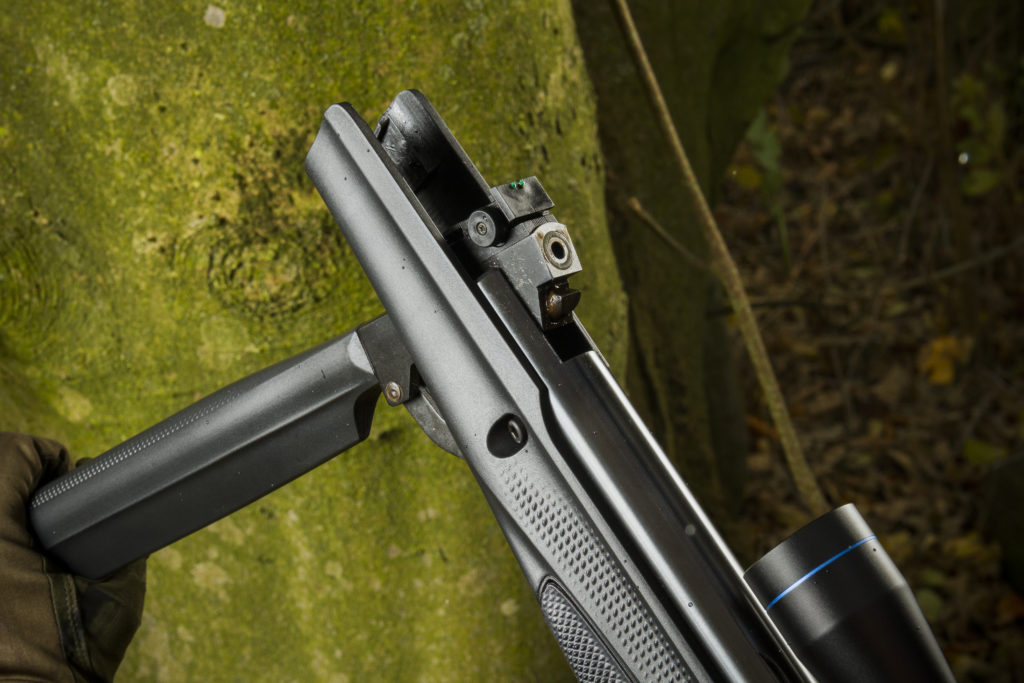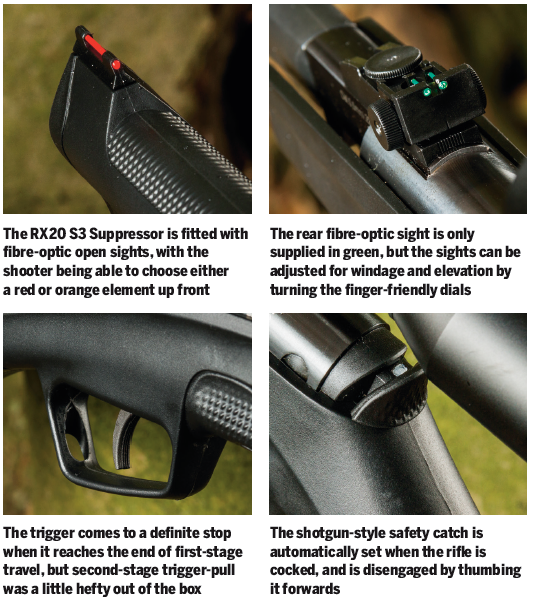Stoeger RX20 S3 Suppressor Combo
Mike Morton goes international with the Stoeger RX20 S3 Suppressor Combo – a break-barrel rifle from an American firm that’s been styled in Italy.

Stoeger RX20 S3 Suppressor Combo
US gun-maker Stoeger headed across the Atlantic and landed in Europe when it created the RX20. This gas-ram has been developed and styled by Italian engineers, and that will be immediately obvious when you take your first look at this gun. The Stoeger RX20 S3 Suppressor Combo, seen here in .22, comes equipped with fibre-optic sights as well as an optional telescopic sight with pre-fitted mounts. But the features that will catch your eye first are the ambidextrous shotgun-style black synthetic stock and the barrel shroud.
Stoeger RX20 S3 Suppressor Combo- key specs
Gun supplied by: GMK (www.gmk.co.uk)}
Manufacturer: Stoeger (www.stoegerairguns.com)
Model: RX20 S3 Suppressor Combo
Price: £250
Available calibres: .177 (4.5mm) and .22 (5.5mm) (tested)
Cocking system: Break-barrel
Power plant: Gas-ram
Trigger: T2 double-stage
Trigger -pull: 4lb 1oz
Safety: Automatic shotgun-style
Front sight: Interchangeable red or orange fibre-optic
Rear sight: Green fibre-optic, fully adjustable for elevation and windage
Stock: Ambidextrous, with optional inserts
Finish: Black synthetic stock, blued steel barrel
Rail for scope: Integral dovetail scope rail on receiver
Scope: 4×32 scope supplied with included mounts
Total length: 42.5in (108cm)
Barrel length: 16.5in (41.97cm)
Weight: 3kg (6.6lb) without scope
The stock may be made of plastic, but it feels reassuringly rigid, which isn’t bad at all for a gun costing £250. It has a Monte Carlo cheekpiece with a slightly raised comb, and these proportions are good for use with both the fibre-optic sights and the supplied scope.
Ergonomics are a key feature of the Stoeger RX20 S3 Suppressor Combo, with multi-directional panels of chequering on the grip and forend. These panels are removable, with the default black ones being treated to a very aggressively moulded pattern, which Stoeger calls ProAdaptive Checkering.

After you’ve given the top of the shroud a sharp tap with the palm of your hand to release the barrel, the RX20 is surprisingly easy to cock
You can swap the panels for either orange or blue alternatives, which are included in the box. These are moulded with a slightly less intrusive stippling pattern called the MultiGrip System. Talking of grips, I would have preferred a steeper rake, but ended up shooting the RX20 thumb-up, which I found more comfortable.
As unusual as the stock is, perhaps the most obvious feature of the S3 Suppressor Combo is – as the name implies – the massive shroud that encases the barrel all the way back to the breech block. I was initially sceptical about how well this would work, because neither gas-rams nor springers are particularly easy to moderate.
But I was pleasantly surprised on this front. When a shot is taken, the air initially travels through a series of baffles in front of the barrel, and is then directed downwards and backwards into the enclosed space below the barrel, which Stoeger calls the decompression chamber. This really does work, and the rifle is certainly quiet enough to be shot at an indoor range for extended periods.
The includes a Stoeger-branded 4×32 scope and mounts, although you’ll have to remove the scope if you want to shoot with the fibre-optic open sights. A dovetail rail has been machined into the action, and there’s a cut-out in the action into which a stop pin can be slotted to prevent scope creep.
I wanted to test the rifle using both sighting systems, and shot it with the scope first. The barrel responds well to the ‘tap it and unwrap it’ method of cocking, where the spring-loaded chisel detent catch is released by a sharp rap to the top of the shroud. After this, I was able to comfortably cock the action normally, and could even do so using just two fingers.
When the rifle was shot over the chronograph using 16 grain Air Arms Diabolo Field pellets, it returned an average velocity of 518 feet per second, translating into a muzzle energy of 9.54 foot pounds. While this is more than adequate for a rifle of this type, what really got me excited was the tiny variation in velocity, which was just under three feet per second over a five-shot string. That’s absolutely fantastic for an ultra high-end rifle, let alone one like this costing £250.

Less fantastic was the two-stage trigger. This is adjustable, but I shot it as it came out of the box, which is standard practice when I shoot review rifles. First-stage travel was light and came to a definite stop, while the second stage exhibited a fair amount of creep before breaking at 4lb 1oz. Nevertheless, I did manage to get used to the trigger with plenty of practice.
Follow-through is critical with both rammers and springers, and I used this opportunity to hone my own technique with this trigger, and recoil was extremely mild. The little 4×32 scope that comes with the gun is a good entry-level optic for plinking, and I was able to see my usual Birchwood Casey 1-inch Target Spots when zeroing the rifle at 25 yards.
At this distance, the rifle was happily hitting a rabbit’s head spinner 100 per cent of the time, and once I’d got used to the trigger, I was able to hit a pigeon’s head spinner at the same distance most of the time. With the scope removed, I shot the rifle with the open sights, using the dials on the rear sight to adjust for windage and elevation.
Once the sights were dialled in at my chosen distance of 15 yards, it was time to get to work again on both the rabbit and pigeon’s head spinners. At 108cm, this rifle is fairly long, but is neutrally balanced just in front of the trigger guard and handles nicely. Despite my misgivings about the weight of trigger-pull, it was certainly fun and easy to shoot.
It’ll certainly turn heads at the club, but I think the natural home for this rifle is the garden plinking range, where it’ll spin those spinners and topple those tins all day long – and without annoying the neighbours either, thanks to that huge suppressor. But regardless of how well this rifle shoots, I suspect it will ultimately be bought by shooters who love its looks.
Its Italian styling is so extreme, it’s probably a love it or hate it kind of thing. A bit like Marmite. But a bit of Marmite is rather nice from time to time…








